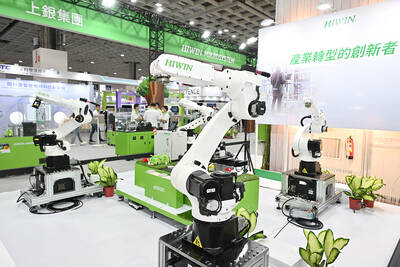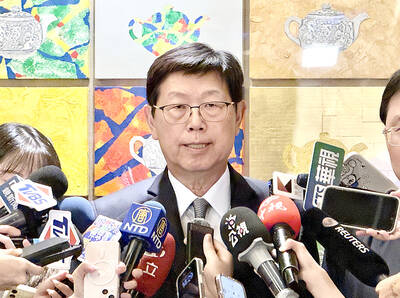AU Optronics Corp (AUO, 友達光電) yesterday said the first quarter of this year was its best first quarter in the past nine years as persistent inventory buildup demand for TV panels pushed prices higher.
The LCD panel maker’s net profit expanded about 5.7 percent to NT$9.48 billion (US$314.4 million), compared with NT$8.97 billion in the fourth quarter of last year, the company’s financial statement showed.
In the first quarter of last year, the company lost NT$5.48 billion.
Average selling prices for the company’s products rose 2 percent in the first quarter to US$421 per square meter, up from US$413 per square meter in the fourth quarter of last year.
That represents an annual jump of 20.63 percent.
“TV vendors continued to replenish inventory in the first quarter. Robust demand has caused a supply crunch,” AUO chairman and chief executive officer Paul Peng (彭双浪) told investors.
“The robust demand is to extend into the second quarter. AUO expects its equipment loading rate to remain at a high gear, or to be almost fully loaded,” he said.
“This will be the longest boom period in the LCD industry’s history. We expect the prosperity to be in place for some time,” he said.
The company said it expects demand growth to outpace supply by about 2 percent this year.
However, it is keeping its capital spending for this year at NT$55 billion, as planned at end of last year.
AUO expects its shipments of PC and TV panels this quarter to shrink by a low-single-digit percentage by unit as it is to ship more large-size and high-end TV panels, such as 65-inch TV panels and 55-inch ultra-high-definition 4K TV panels, which will consume more capacity.
“As TV sets become slimmer, the uptake of 65-inch and 70-inch TVs is improving,” AUO president Michael Tsai (蔡國新) said. “Clients are also asking for more supply of such panels.”
Prices for TV panels are expected to rise by a low-single digit percentage this quarter from last quarter, AUO said.
However, exchange rates might have a greater impact on the company’s business in the first half of the year, Peng said.
A stronger New Taiwan dollar would weaken AUO’s price competitiveness, he said.
Against the US dollar, the NT dollar appreciated 5.6 percent in the first quarter of the year, faster than South Korean won’s 4.1 percent, while Chinese yuan fell 5.3 percent, he said.
AUO also said it has made significant progress this year in expanding its client base for OLED panels.
Monthly shipments of OLED panels for wearable devices, mostly smart watches, are expected to reach 1 million units in the second half of the year, the company said.

AI SERVER DEMAND: ‘Overall industry demand continues to outpace supply and we are expanding capacity to meet it,’ the company’s chief executive officer said Hon Hai Precision Industry Co (鴻海精密) yesterday reported that net profit last quarter rose 27 percent from the same quarter last year on the back of demand for cloud services and high-performance computing products. Net profit surged to NT$44.36 billion (US$1.48 billion) from NT$35.04 billion a year earlier. On a quarterly basis, net profit grew 5 percent from NT$42.1 billion. Earnings per share expanded to NT$3.19 from NT$2.53 a year earlier and NT$3.03 in the first quarter. However, a sharp appreciation of the New Taiwan dollar since early May has weighed on the company’s performance, Hon Hai chief financial officer David Huang (黃德才)

The Taiwan Automation Intelligence and Robot Show, which is to be held from Wednesday to Saturday at the Taipei Nangang Exhibition Center, would showcase the latest in artificial intelligence (AI)-driven robotics and automation technologies, the organizer said yesterday. The event would highlight applications in smart manufacturing, as well as information and communications technology, the Taiwan Automation Intelligence and Robotics Association said. More than 1,000 companies are to display innovations in semiconductors, electromechanics, industrial automation and intelligent manufacturing, it said in a news release. Visitors can explore automated guided vehicles, 3D machine vision systems and AI-powered applications at the show, along

FORECAST: The greater computing power needed for emerging AI applications has driven higher demand for advanced semiconductors worldwide, TSMC said The government-supported Industrial Technology Research Institute (ITRI) has raised its forecast for this year’s growth in the output value of Taiwan’s semiconductor industry to above 22 percent on strong global demand for artificial intelligence (AI) applications. In its latest IEK Current Quarterly Model report, the institute said the local semiconductor industry would have output of NT$6.5 trillion (US$216.6 billion) this year, up 22.2 percent from a year earlier, an upward revision from a 19.1 percent increase estimate made in May. The strong showing of the local semiconductor industry largely reflected the stronger-than-expected performance of the integrated circuit (IC) manufacturing segment,

COLLABORATION: Softbank would supply manufacturing gear to the factory, and a joint venture would make AI data center equipment, Young Liu said Hon Hai Precision Industry Co (鴻海精密) would operate a US factory owned by Softbank Group Corp, setting up what is in the running to be the first manufacturing site in the Japanese company’s US$500 billion Stargate venture with OpenAI and Oracle Corp. Softbank is acquiring Hon Hai’s electric-vehicle plant in Ohio, but the Taiwanese company would continue to run the complex after turning it into an artificial intelligence (AI) server production plant, Hon Hai chairman Young Liu (劉揚偉) said yesterday. Softbank would supply manufacturing gear to the factory, and a joint venture between the two companies would make AI data